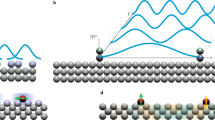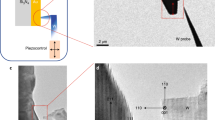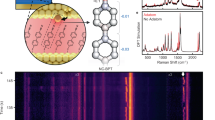Atoms crammed tightly together in metal crystal surfaces are surprisingly mobile.
Abstract
Atoms in close-packed surfaces of metal crystals move around at surprisingly high rates, even though each atom is locked in tightly by its neighbours. Here we use a low density of indium atoms, embedded in the outermost atomic layer of a copper surface, as tracer particles for scanning tunnelling microscopy to reveal the high vacancy-assisted mobility of atoms in this surface. We believe that most close-packed surfaces of metals and other materials will exhibit a similar vacancy-assisted motion at room temperature, with such surfaces behaving like a gigantic atomic slide-puzzle.
Similar content being viewed by others
Main
We deposited indium on a clean Cu(001) surface, one of the naturally occurring facets on a copper crystal, in an ultrahigh vacuum system and then watched the diffusion of individual indium atoms at room temperature using a scanning tunnelling microscope1 (STM). The surface consists of atomic 'steps' separating atomically flat copper 'terraces'. The indium atoms are rapidly incorporated in the outermost atomic layer, where each one replaces a single copper atom (refs 2, 3; and R.v.G. et al., manuscript submitted).
To our surprise, we found that the embedded indium atoms are mobile and that they 'jump' over distances larger than one lattice spacing, some of them as far as five lattice spacings. The root-mean-square jump length is 1.92 lattice spacings; these jumps are separated by relatively long intervals of about 100 seconds at room temperature. Neighbouring indium atoms show a strong tendency to jump simultaneously (Fig. 1 represents a typical sequence of STM images illustrating these observations).
The fine corrugation is due to the atomic lattice of the Cu(001) surface. The four protrusions are individual indium atoms, each one replacing a single copper atom in the surface layer. a, Starting situation at t = 0 s; b, the positions of the four indium atoms are still identical to those in a, despite the fact that 140 s has passed; c, 20 s later, three of the four indium atoms have moved up to 5 atomic spacings. All motion exhibits this pattern of long waiting times followed by simultaneous displacements of several indium atoms over long distances.
We can explain this peculiar motion of the indium by assuming that it is assisted by a rapidly diffusing 'mystery particle' that remains invisible to the STM. During its fast two-dimensional random walk, there will be a high probability that this particle will encounter an indium atom several times, thereby displacing it over more than a single lattice spacing in a time that is too short to be resolved by the STM and giving rise to the long jumps. The mystery particle will also have a high probability of encountering other indium atoms in the direct vicinity, which explains the simultaneous jumps.
There are two naturally occurring particles that might act in the assisting role invoked here, namely adatoms (single copper atoms on top of the surface) and vacancies (atoms missing from the first layer). We have observed that the indium atoms, immediately after deposition on top of the surface, invade the first copper layer via the steps, which rules out the possibility that adatoms assist the indium motion by changing places with the indium — in that case, most indium atoms would have entered the copper layer at a point close to where they had landed, resulting in a homogeneous population of the terraces with indium. We conclude that surface vacancies are responsible for the diffusion of the indium atoms.
Our interpretation that each long jump reflects the passage of a single assisting entity — in this case a vacancy — is corroborated by the measured distribution of jump lengths. The shape of this distribution is described well by a modified Bessel function, as expected for this type of diffusion (ref. 4; and R.v.G. et al., manuscript submitted), rather than the ordinary Gauss function expected for an unassisted random walk of the indium. The distribution of waiting times between successive jumps is purely exponential, which shows that subsequent (long) jumps are the effect of the passage of different vacancies.
The indium atoms should be regarded merely as tracer particles — the observed motion of the indium reflects the diffusion of all copper atoms in the surface layer. Model calculations show, however, that the width of the measured jump-length distribution implies a noticeable short-range attraction between the indium and the vacancies, which makes the average jump length of the indium atoms somewhat larger than that of the copper atoms (without affecting the average jump frequency). The mechanism by which surface vacancies allow the diffusion of atoms in the surface is like a slide-puzzle, in which a set of square tiles can be rearranged completely by sliding a single missing tile through the puzzle.
References
Hoogeman, M. S. et al. Rev. Sci. Instr. 69, 2072– 2080 (1998).
Breeman, M. & Boerma, D. O. Phys. Rev. B 46, 1703–1709 (1992).
Breeman, M. & Boerma, D. O. Surf. Sci. 287/ 288, 881–885 (1993).
Brummelhuis, M. J. A. M. & Hilhorst, H. J. J. Stat. Phys. 53, 249–278 (1988).
Author information
Authors and Affiliations
Supplementary information
Rights and permissions
About this article
Cite this article
van Gastel, R., Somfai, E., van Saarloos, W. et al. A giant atomic slide-puzzle. Nature 408, 665 (2000). https://doi.org/10.1038/35047156
Issue Date:
DOI: https://doi.org/10.1038/35047156
Comments
By submitting a comment you agree to abide by our Terms and Community Guidelines. If you find something abusive or that does not comply with our terms or guidelines please flag it as inappropriate.




